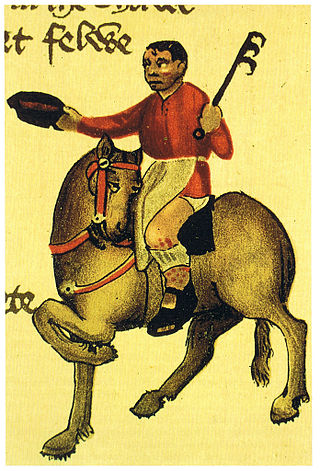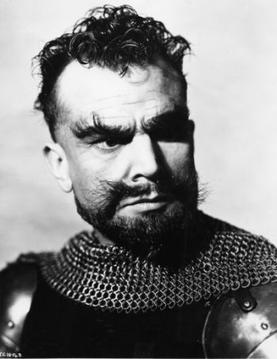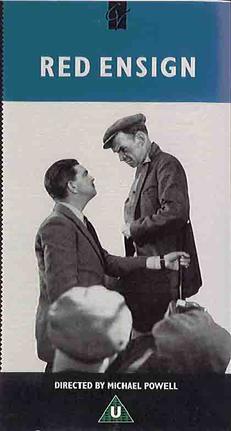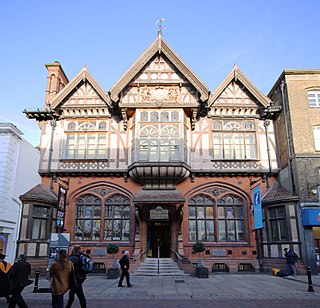
The Canterbury Tales is a collection of twenty-four stories that runs to over 17,000 lines written in Middle English by Geoffrey Chaucer between 1387 and 1400. It is widely regarded as Chaucer's magnum opus. The tales are presented as part of a story-telling contest by a group of pilgrims as they travel together from London to Canterbury to visit the shrine of Saint Thomas Becket at Canterbury Cathedral. The prize for this contest is a free meal at the Tabard Inn at Southwark on their return.

The River Stour(, rhymes with "flour") is a river in Kent, England that flows into the North Sea at Pegwell Bay. Above Plucks Gutter, where the Little Stour joins it, the river is normally known as the Great Stour. The upper section of the river, above its confluence with the East Stour at Ashford is sometimes known as the Upper Great Stour or West Stour. In the tidal lower reaches, the artificial Stonar Cut short cuts a large loop in the natural river.

Michael Latham Powell was an English filmmaker, celebrated for his partnership with Emeric Pressburger. Through their production company The Archers, they together wrote, produced and directed a series of classic British films, notably The Life and Death of Colonel Blimp (1943), A Canterbury Tale (1944), I Know Where I'm Going! (1945), A Matter of Life and Death, Black Narcissus (1947), The Red Shoes (1948), and The Tales of Hoffmann (1951).

"The Cook's Tale" is one of the Canterbury Tales by Geoffrey Chaucer. It breaks off after 58 lines and was presumably never finished, although some scholars argue that Chaucer deliberately left the tale unfinished. The story starts telling of an apprentice named Perkyn who is fond of drinking and dancing. Perkyn is released by his master and moves in with a friend who also loves to drink, and whose wife is a shopkeeper whose real occupation is that of a prostitute.

A Matter of Life and Death is a 1946 British fantasy-romance film set in England during World War II.

Fordwich is a market town and a civil parish in east Kent, England, on the River Stour, northeast of Canterbury.

Canterbury, commonly called the City of Canterbury, is a local government district with city status in Kent, England. As well as Canterbury itself, the district extends to the towns of Fordwich, Herne Bay and Whitstable.

The Pilgrims' Way is the historical route supposedly taken by pilgrims from Winchester in Hampshire, England, to the shrine of Thomas Becket at Canterbury in Kent. This name, of comparatively recent coinage, is applied to a pre-existing ancient trackway dated by archaeological finds to 600–450 BC, but probably in existence since the Stone Age. The prehistoric route followed the "natural causeway" east to west on the southern slopes of the North Downs.

The British film-making partnership of Michael Powell (1905–1990) and Emeric Pressburger (1902–1988)—together often known as The Archers, the name of their production company—made a series of influential films in the 1940s and 1950s. Their collaborations—24 films between 1939 and 1972—were mainly derived from original stories by Pressburger with the script written by both Pressburger and Powell. Powell did most of the directing while Pressburger did most of the work of the producer and also assisted with the editing, especially the way the music was used. Unusually, the pair shared a writer-director-producer credit for most of their films. The best-known of these are The Life and Death of Colonel Blimp (1943), A Canterbury Tale (1944), I Know Where I'm Going! (1945), A Matter of Life and Death (1946), Black Narcissus (1947), The Red Shoes (1948), and The Tales of Hoffmann (1951).

One of Our Aircraft Is Missing is a 1942 British black-and-white war film, mainly set in the German-occupied Netherlands. It was the fourth collaboration between the British writer-director-producer team of Michael Powell and Emeric Pressburger and the first film they made under the banner of The Archers.

The Canterbury Tales is a 1972 Italian film directed by Pier Paolo Pasolini based on the medieval narrative poem by Geoffrey Chaucer. The second film in Pasolini's "Trilogy of Life", preceded by The Decameron and followed by Arabian Nights, it won the Golden Bear at the 22nd Berlin International Film Festival.

Esmond Penington Knight was an English actor. He had a successful stage and film career before World War II. For much of his later career Knight was half-blind. He had been badly wounded in 1941 while on active service on board HMS Prince of Wales when she fought the Bismarck at the Battle of the Denmark Strait, and remained totally blind for two years, though he later regained some sight in his right eye.

Chilham is a mostly agricultural village and parish in the English county of Kent with a clustered settlement, Chilham village centre, in the northeast, and a smaller linear settlement, Shottenden. Well-preserved roads and mostly residential listed buildings in its centre have led to its use as a location in television and film.

Red Ensign is a 1934 film directed by British filmmaker Michael Powell. It is an early low-budget "quota quickie".

The Canterbury Tales is a series of six single dramas that originally aired on BBC One in 2003. Each story is an adaptation of one of Geoffrey Chaucer's 14th-century Canterbury Tales. While the stories have been transferred to a modern, 21st-century setting, they are still set along the traditional Pilgrims' route to Canterbury.
John Sweet was a US Army sergeant serving in the UK in World War II when he was selected by Michael Powell and Emeric Pressburger to play the role of Sgt. Bob Johnson, one of the three pilgrims in the 1944 feature film A Canterbury Tale.
The Canterbury Tales is a 14th-century English collection of stories, mainly in verse, written by Geoffrey Chaucer.
Józef Żmigrod, better known by his stage name, Allan Gray, was a Polish composer, best known for his film scores.

The Beaney House of Art and Knowledge is the central museum, library and art gallery of the city of Canterbury, Kent, England. It is housed in a Grade II listed building. Until it closed for refurbishment in 2009, it was known as the Beaney Institute or the Royal Museum and Art Gallery. It reopened under its new name in September 2012. The building, museum and art gallery are owned and managed by Canterbury City Council; Kent County Council is the library authority. These authorities work in partnership with stakeholders and funders.

The Eve of St Mark is a 1942 play by Maxwell Anderson set during World War II. It later became a 1944 film by 20th Century Fox that featured some of the same actors who repeated their roles in the film. The title is derived from the legend of St. Mark's Eve and the title of an uncompleted 1819 poem by John Keats.



















